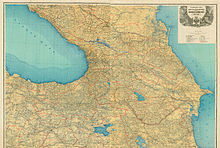| Transcaucasian Commissariat Закавказский Комиссариат Zakavkazskij Komissariat | |||||||||
|---|---|---|---|---|---|---|---|---|---|
| Autonomous area of Russia | |||||||||
| 1917–1918 | |||||||||
 | |||||||||
| Capital | Tiflis (now Tbilisi) | ||||||||
| Government | |||||||||
| • Type | Commissariat | ||||||||
| Chairman | |||||||||
• 1917–1918 | Evgeni Gegechkori | ||||||||
| History | |||||||||
• Established | 11 November 1917 | ||||||||
| 22 April 1918 | |||||||||
| |||||||||
The Transcaucasian Commissariat was established at Tbilisi on 11 November 1917, as the first government of the independent Transcaucasia following the October Revolution in Petrograd. The Commissariat decided to strengthen the Georgian–Armenian–Azerbaijani union by convoking a Diet or general assembly (Sejm) in January 1918.[1][2] It declared independence from Soviet Russia and formed the Transcaucasian Democratic Federative Republic after being faced with the threat of being overrun by the Ottoman invasion.[3]

- ^ Richard Pipes, The formation of the Soviet Union, page 103.
- ^ Swietochowski, Tadeusz (1985). Russian Azerbaijan, 1905–1920: The Shaping of a National Identity in a Muslim Community. United Kingdom: Cambridge University Press. p. 106. ISBN 0-521-26310-7. Retrieved July 9, 2010.
- ^ Kenez, Peter (2004). Red Attack, White Resistance; Civil War in South Russia 1918. Washington, DC: New Academia Publishing. pp. 240–241. ISBN 9780974493442.